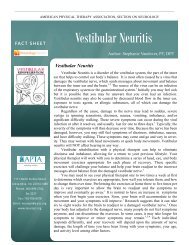Cervicogenic Dizziness - Neurology Section
Cervicogenic Dizziness - Neurology Section
Cervicogenic Dizziness - Neurology Section
Create successful ePaper yourself
Turn your PDF publications into a flip-book with our unique Google optimized e-Paper software.
AMERICAN PHYSICAL THERAPY ASSOCIATION, SECTION ON NEUROLOGYFA C T S H E E T<strong>Cervicogenic</strong> <strong>Dizziness</strong>Author: Jean Marie Berliner, PT, DPT, NCSOverview: The term cervicogenic dizziness is currently used in practice to describesymptoms of dizziness that arise from the cervical spine. 1,2 It is referred toas cervical vertigo, proprioceptive vertigo, cervicogenic vertigo, and cervical dizziness.3 It has been found that the neck plays a critical role in balance. 4 Abnormalafferent signals from the neck can create various sensations of altered orientationin space and disequilibrium. 3,5 The physiologic mechanisms of cervicogenic dizzinessare believed to be from 1) vasomotor changes due to irritation of the cervicalsympathetic chain, 2) vertebrobasilar insufficiency/ vascular compression, or 3)altered proprioceptive input from the upper cervical spine. 1,6,7 <strong>Dizziness</strong> with cervicalspine dysfunction frequently results from flexion-extension injuries such as awhiplash injury. 5 Additionally, patients with prior vestibular insults may modifyor restrict head motion, thereby altering normal cervical spine mechanics and leadingto further symptoms of dizziness from cervical origin.Symptoms: Can vary significantly from person to person. Some of the most commonsymptoms observed are: 1-9<strong>Dizziness</strong>Disequilibrium“Swimming sensation”Difficulty sleeping due to painAtaxiaPostural imbalance with neck painCervical painVertigo<strong>Dizziness</strong> associated with headachesCervical range of motion restrictionsReferred pain to shoulders or scapular areaUnsteadiness of gaitHeadachesTinnitus1111 North Farifax StreetAlexandria, VA 22314-1488Phone: 800-999-2782,Ext 3237Fax: 703-706-8578Email: neuropt@apta.orgwww.neuropt.orgHearing lossLightheadednessNauseaWoozinessDiagnosis: There is no “gold standard” definition or diagnostic tests to identifycervicogenic dizziness as well as no definitive treatment progression. 1,2,4,5,7,8 Avariety of various differential diagnoses can present similar to cervicogenic dizzinessand a combination of neck pain and dizziness should not be the only characteristicsused to describe this disorder. 7 <strong>Cervicogenic</strong> dizziness can be defined asthe presence of dizziness, imbalance or unsteadiness related to movements or positionof the cervical spine, or occurring with a stiff or painful neck. 3 Diagnosis ofcervicogenic dizziness is often considered a diagnosis of exclusion. 5 Differentialdiagnosis of dizziness from vertebrobasilar insufficiency is usually accompanied(continued on next page)
AMERICAN PHYSICAL THERAPY ASSOCIATION, SECTION ON NEUROLOGYAcoustic Neuromaby other symptoms including visual hallucinations, drop attacks, loss of vision orvisual field defects, diplopia, and headaches. 2 A detailed history, comprehensiveclinical examination, vestibular function tests, and possible radiological evaluationprovide information for the diagnosis. 2,5 The clinical exam should include an oculomotorexam, posture assessment, active and passive range of motion of the cervicalspine, instability of the cervical spine (including alar ligament testing), mobilityof the cervical vertebral column (including a segmental exam of the cervicalspine), compression and distraction of the cervical spine, palpation, pain, and aneurologic exam. 2,5,6,7 The clinical neck torsion nystagmus test is commonly usedfor diagnosis although it is not specific for cervicogenic dizziness. 2,4,5 A positiveresult is nystamgus as well as provocation of symptoms. 2 Smooth pursuit withneck rotated can also be used to diagnose but may require specialized equipment,such as infrared goggles or frenzel lenses. 5 Manual cervical traction can also indicatea cervical component if there is a reduction in symptoms during traction. 2 TheSpurling Test evaluates the patient for cervical spine impingement.Treatment: Intervention is prescribed on an individual basis depending on theclinical findings. 2,4 There is moderate evidence to support the use of manual therapytechniques, such as mobilization and manipulation, in the treatment of cervicogenicdizziness. 3 The use of vestibular therapy in conjunction with manual therapyhas not been as well studied. However, sound rationale for the use of vestibulartherapy in conjunction with manual therapy in cervicogenic dizziness treatmenthas been well described. 3 The central and peripheral vestibular system may be involvedsimultaneously and both may need to be addressed. 4 Cervical spine dysfunctionsshould also be addressed through manual or mechanical traction, activeand passive range of motion, strengthening of the deep neck flexors, postural reeducation,massage, trigger point injections, modalities, and biofeedback. 2,4,5,6 Cervicalkinesthesia training is another important aspect of treatment. 2 These include avariety of eye fixation or tracking exercises combined with head movements. 2,7In the acute phases following traumatic injury, muscle relaxants and soft cervicalcollars may be considered. 4 Use of a soft cervical collar should be limited only tothe acute phase and should not be worn more than 1-2 hours per day. 4 Use of acervical collar beyond these guidelines may actually aggravate the condition.1111 North Farifax StreetAlexandria, VA 22314-1488Phone: 800-999-2782,Ext 3237Fax: 703-706-8578Email: neuropt@apta.orgwww.neuropt.orgReferences:1. Reid SA, Rivett DA. Manual therapy treatment of cervicogenic dizziness: a systematic review. Man Ther.2005;10:4-13.2. Herdman SJ. Vestibular Rehabilitation. 3 rd ed. Philadelphia: F.A. Davis Company; 2007.3. Lystad RP. Bell G, Bonnevie-Svendsen M, Carter CV. Manual therapy with and without vestibular rehabilitationfor cervicogenic dizziness: a systematic review. Chiropractic & Manual Therapies. 2011,19:21.4. Furman JM, Whitney SL. Central causes of dizziness. Phys Ther. 2000;80:179-187.5. Wrisley DM, Sparto PJ, Whitney SL. <strong>Cervicogenic</strong> dizziness: a review of diagnosis and treatment. J OrthopSports Phys Ther. 2000;30(12):755-766.6. Biesinger E. Vertigo caused by disorders of the cervical vertebral column. Adv. Oto-Rhino-Laryg.1988;39:44-51.7. Bracher ES, Almeida CI, Almeida RR, Duprat AC, Bracher CB. A combined approach for the treatment ofcervical vertigo. J Manip Phys Ther. 2000;23(2):96-100.8. Morinaka S. Musculoskeletal diseases as a causal factor of cervical vertigo. Auris Nasus Larynx.2009;36:649-654.9. Karlberg M, Magnusson M, Malmstrom EM, Melander A, Moritz U. Postural and symptomatic improvement afterphysiotherapy in patients with dizziness of suspected cervical origin. Phys Med Rehabil. 1996;77(9):874-882.
















